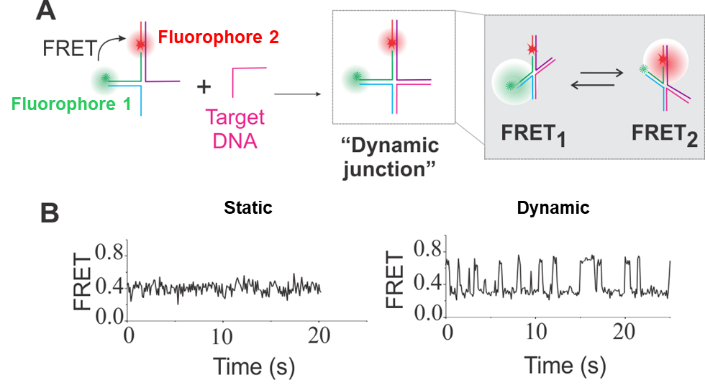Disease detection & diagnosis
Dynamic FRET-based Sensors
Ultrasensitive detection of nucleic acids biomarkers
Fluorescence resonance energy transfer (FRET)-based sensors are useful tools for ultrasensitive detection of nucleic acid biomarkers. FRET is a mechanism by which energy is transferred from one fluorophore (donor) to another (acceptor). Since the efficiency of FRET relies on distance between the donor/acceptor pair, it allows detection of target via target-dependent conformational change (and hence the FRET efficiency) of the sensors. However, false positives can be a limiting factor for high-confidence detection in typical FRET experiments with binary readout (low FRET or high FRET). Thus, current FRET-based sensors often require a complex design with steps for target labeling, signal amplification and/or use of nanomaterials. In order to address these issues, VCU researchers have developed a simple FRET-based single-molecule sensor that can provide high-confidence and ultrasensitive detection of nucleic acid biomarkers, without the need for target labeling and signal amplification.
The technology
This single-step FRET-based sensor is composed of a 4-way DNA junction, with two of the strands being labeled with a fluorophore (Figure 1A). The sensor is designed to exhibit static FRET in the absence of a target. However, upon binding of the target sequence, a dynamic FRET is observed (Figure 1B). The dynamic FRET is caused by the target completing the 4-Way DNA junction, which spontaneously interconverts between two different conformers. The dynamic nature of the four-way junction reduces the potential for a false signal, eliminates the need to label targets, and allows them to bind directly with no competition. Therefore, this sensor can be easily adapted to detect any sequences with high confidence. These features make our sensor a powerful tool for early diagnosis of disease and a potential detection method for COVID-19 via detection of SARS-CoV2-RNA.

Figure 1. Working principle of the sensor; (A) Binding of a target completes the four-way junction, resulting in dynamic switching between a low (FRET1) and a high (FRET2) FRET states; (B) Typical FRET traces in the absence (left) and presence (right) of target DNA.
